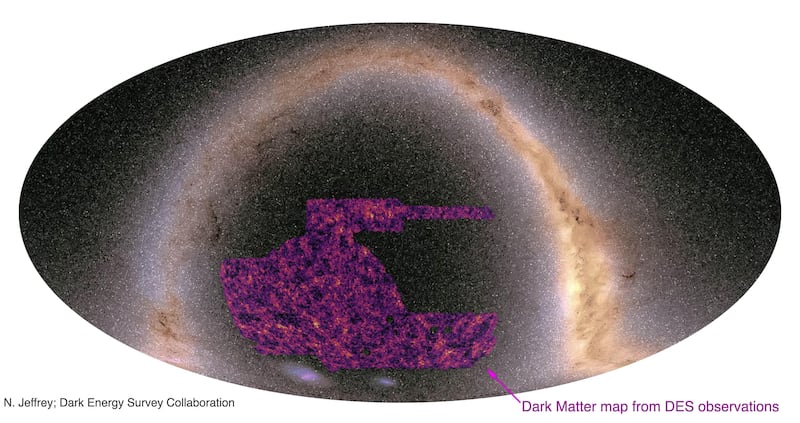Researchers have created the largest ever map of dark matter, invisible material thought to account for 80 per cent of the total matter of the universe.
As matter curves space-time, astronomers are able to map its existence by looking at light travelling to Earth from distant galaxies.
If the light has been distorted, this means there is matter in the foreground, bending the light as it comes towards us.

A team co-led by UCL researchers, as part of the international Dark Energy Survey (DES), used artificial intelligence to analyse images of 100 million galaxies, looking at their shape, spots of light made up of 10 or so pixels, to see if they have been stretched.
The new map, a representation of all matter detected in the foreground of the observed galaxies, covers one-quarter of the southern hemisphere’s sky.
Co-lead author Dr Niall Jeffrey, of UCL's physics and astronomy department, said: "Most of the matter in the universe is dark matter.
“It is a real wonder to get a glimpse of these vast, hidden structures across a large portion of the night sky.
"These structures are revealed using the distorted shapes of hundreds of millions of distant galaxies with photographs from the Dark Energy Camera in Chile.
“In our map, which mainly shows dark matter, we see a similar pattern as we do with visible matter only, a web-like structure with dense clumps of matter separated by large empty voids.
“Observing these cosmic-scale structures can help us to answer fundamental questions about the universe.”
For decades astronomers have suspected there is more material in the universe than we can see.
Dark matter, like dark energy, remains mysterious, but its existence is inferred from galaxies behaving in unpredicted ways – for instance, the fact that galaxies stay clustered together, and that galaxies within clusters move faster than expected.
Densest regions
Co-author Prof Ofer Lahav, also of UCL and chairman of the DES UK consortium, said: "Visible galaxies form in the densest regions of dark matter.
“When we look at the night sky, we see the galaxy’s light but not the surrounding dark matter, like looking at the lights of a city at night.
“By calculating how gravity distorts light, a technique known as gravitational lensing, we get the whole picture, both visible and invisible matter.
“This brings us closer to understanding what the universe is made of and how it has evolved.
“It also shows the power of artificial intelligence methods to analyse one of the largest datasets in astronomy.”
The map is described in a new paper posted on the DES website and to be published in the Monthly Notices Of The Royal Astronomical Society. –PA













